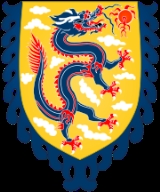
Chinese dragon
Overview
Chinese dragons are legendary creatures in Chinese mythology
and folklore
, with mythic counterparts among Japanese
, Korean
, Vietnamese
, Bhutanese
, Western and Turkic dragons. In Chinese art
, dragon
s are typically portrayed as long, scaled, serpentine creatures with four legs. In yin and yang
terminology, a dragon is yang and complements a yin fenghuang
("Chinese phoenix").
In contrast to European dragon
s, which are considered evil, Chinese dragons traditionally symbolize potent and auspicious powers, particularly control over water, rainfall, hurricane, and floods.
Chinese mythology
Chinese mythology is a collection of cultural history, folktales, and religions that have been passed down in oral or written tradition. These include creation myths and legends and myths concerning the founding of Chinese culture and the Chinese state...
and folklore
Chinese folklore
Chinese folklore includes songs, dances, puppetry, and tales. It often tells stories of human nature, historical or legendary events, love, and the supernatural, or stories explaining natural phenomena and distinctive landmarks.-Folktales:...
, with mythic counterparts among Japanese
Japanese dragon
Japanese dragons are diverse legendary creatures in Japanese mythology and folklore. Japanese dragon myths amalgamate native legends with imported stories about dragons from China, Korea and India. The style of the dragon was heavily influenced by the Chinese dragon...
, Korean
Korean dragon
Korean dragons are legendary creatures in Korean mythology and folklore.The style of the dragon was heavily influenced by the Chinese dragon. Although generally comparable with Chinese dragons in appearance and symbolic significance, Korean dragons have unique culture-specific properties that...
, Vietnamese
Vietnamese dragon
Vietnamese dragons are symbolic creatures in the folklore and mythology of Vietnam. According to an ancient creation myth, the Vietnamese people are descended from a dragon and a fairy....
, Bhutanese
Druk
The Druk is the "Thunder Dragon" of Bhutanese mythology and a Bhutanese national symbol. A druk appears on the Bhutanese Flag, holding jewels to represent wealth. In the Dzongkha language, Bhutan is called Druk Yul, or Land of Druk, and Bhutanese leaders are called Druk Gyalpo, Dragon Kings...
, Western and Turkic dragons. In Chinese art
Chinese art
Chinese art is visual art that, whether ancient or modern, originated in or is practiced in China or by Chinese artists or performers. Early so-called "stone age art" dates back to 10,000 BC, mostly consisting of simple pottery and sculptures. This early period was followed by a series of art...
, dragon
Dragon
A dragon is a legendary creature, typically with serpentine or reptilian traits, that feature in the myths of many cultures. There are two distinct cultural traditions of dragons: the European dragon, derived from European folk traditions and ultimately related to Greek and Middle Eastern...
s are typically portrayed as long, scaled, serpentine creatures with four legs. In yin and yang
Yin and yang
In Asian philosophy, the concept of yin yang , which is often referred to in the West as "yin and yang", is used to describe how polar opposites or seemingly contrary forces are interconnected and interdependent in the natural world, and how they give rise to each other in turn. Opposites thus only...
terminology, a dragon is yang and complements a yin fenghuang
Fenghuang
Fenghuang are mythological birds of East Asia that reign over all other birds. The males are called Feng and the females Huang. In modern times, however, such a distinction of gender is often no longer made and the Feng and Huang are blurred into a single feminine entity so that the bird can be...
("Chinese phoenix").
In contrast to European dragon
European dragon
European dragons are legendary creatures in folklore and mythology among the overlapping cultures of Europe.In European folklore, a dragon is a serpentine legendary creature. The Latin word draco, as in constellation Draco, comes directly from Greek δράκων,...
s, which are considered evil, Chinese dragons traditionally symbolize potent and auspicious powers, particularly control over water, rainfall, hurricane, and floods.
Unanswered Questions

